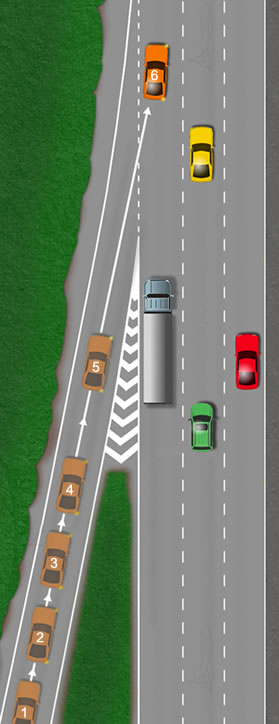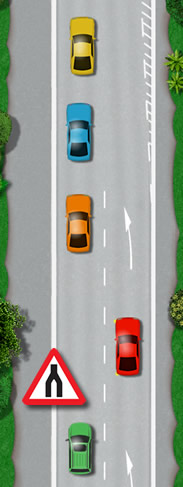Whether learning to drive or a full licence holder, there will be occasions when you need to merge into traffic. For many, merging can be a daunting procedure due to it often being performed at speed.
With a little knowledge and practice, confidence will be gained in no time. As a driver, you’ll be merging into traffic by either a slip road used to merge into a new road. This could be when you’re joining a dual carriageway or motorway for example, or another example, when you’re driving on a road with two or more lanes and where your lane then merges into another.
Motorway driving will become optional for learner drivers being taught with a ADI in 2018. See Can learners drive on motorways for further information.
This guide will offer safety procedures and tips for both forms of merging into traffic.
Merging onto a Dual Carriageway / Motorway
Not only learner drivers, but some full licence holders can find merging onto a fast dual carriageway or motorway a nerve-racking experience. Here’s how to merge onto a dual carriageway or motorway via a slip road:

- In order to merge safely, you’ll need to match the speed of the traffic already on the highway. The moment you enter the slip road, observe traffic on the highway to establish their speed and the density of traffic. If traffic is moving freely, you’ll need to begin accelerating.
- As you begin accelerating, you now need to establish your entrance point onto the highway. You’ll need to observe traffic on the highway for this, but you also need to look where you’re going, so keep alternating observations between your direction of travel and what’s on the highway. Look out for a good sized gap between two vehicles and mark that as your entrance point. Around halfway down the slip road, apply your right signals as this allows you to be better seen by traffic on the highway.
- You should now be approaching 60 to 70 mph to match the speed of traffic on the highway. You now need to alternate your speed based on your chosen entrance point. This may require speeding up or slowing down a little.
- As you get close to the highway entrance, take a quick look over your right shoulder into the blind spot to ensure there are no vehicles that you cannot see in your mirrors.
- Avoid driving over solid white lines and chevron road markings.
- Access the highway into the left lane. To establish what vehicles are around you and their distance, check your mirrors and ensure you cancel your signals. If you enter the highway a little close to the vehicle in front, check your mirrors and increase your following distance if safe to do so. Alternatively, you can overtake the vehicle if it’s safe and legal to do so. Remember to always follow the 2 second rule.
Drivers Already on the Carriageway
If already driving on the carriageway, remain observant for road signs warning you that traffic may be entering the carriageway ahead via a slip road. In this instance, you may need to slow down to allow traffic to enter the carriageway or move over into an overtaking lane if safe to do so. For further information on laws and how to use dual carriageways and motorways, see:
How to Merge into Traffic Two Lanes into One
Another situation where you’ll likely find yourself merging into traffic is when a dual carriageway ends, where two lanes become one. As the role of the driver in the right-hand overtaking lane:
- Remain observant for road signs, in this instance the red triangle warning that the road ahead is merging.
- Prepare to move over into the left-hand lane by first checking your interior mirror followed by your left door mirror. You check both mirrors because you’ll often see something in one mirror that you do not see in another. Ensure that you have a safe gap to move into with a good distance between you and any vehicle in front and behind.
- Unless you are absolutely certain it’s safe to move over, take a quick look over your left shoulder into the left-rear window to ensure an easily obscured vehicle such as a motorcyclist isn’t there. Small vehicles can easily be missed or unseen in a mirrors blind spot.
- To warn other traffic of your intentions, signal to the left.
- Once you have moved into the left lane, cancel your indicators, then check your rear mirror. You check your rear mirror because traffic typically reduces in speed at the end of a dual carriageway. If a vehicle is following closely, gently reduce speed sooner rather than later to avoid harsh braking when the carriageway merges.

Along with directional arrows warning you to move over, you’ll also see lane reduction hatched markings. If they are surrounded by a broken line, you may legally drive on them though it is not recommended as they are in place to separate your lane from oncoming traffic. See hatched road markings.
Drivers Already in the Left Lane
As the role of a driver already in the left-hand lane, at the approach to the end of the carriageway, always check your mirrors for overtaking vehicles that leave moving over till very late. It may be necessary to slow down to allow them to pass before the road narrows.

I have been told that moving from a feeder road onto another road (not a Motorway) where your traffic light is green means you can procede when it is safe to do so. i.e. there is no traffic on the other road, stationary or movng, no pedestrians crossing, i.e. no impediment to proceeding on to the other road. Proceeding onto a road in these circumstances without at the very least looking to the right to see if there are cars approaching could result in a crash and a claim of ‘driving without due care and attention’
Can I use the “How to merge onto a dual carriageway / motorway” photo scenario? I will make sure to reference this company for copyright purposes?
Hi Sarah,
Yes, no problem.